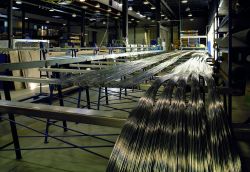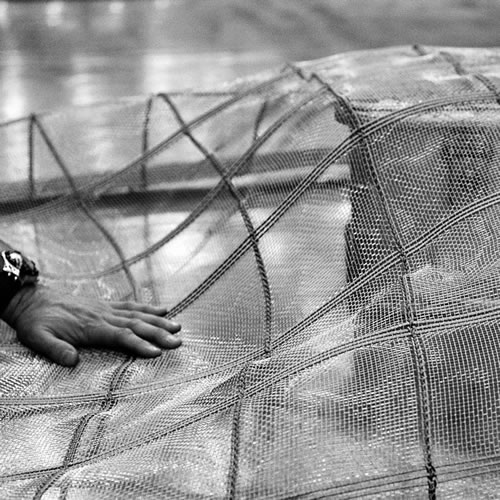The development of metallic fabrics for architecture and design
By Stephan Kufferath, director at GKD

 "In 1992 GKD – a leading weaver of woven metals with manufacturing units in Germany, the USA, Spain and South Africa –
established a first contact with Dominique Perrault endeavoring to assist this
famous as well as innovative architect in his interest and research on woven
metals for use in architecture, particularly focusing on the interior design of
the Bibliothèque nationale de France. On previous projects Perrault had already
worked with synthetic fabrics, but for the Library only non- inflammable
materials, such as metallic fabrics, could be accepted.
Interesting technical aspects of
stainless steel meshes were discovered, such as resistance, durability,
rigidity under tension, maintenance, acoustic qualities, etc. Metallic fabrics
often solve several functional problems at once, problems that the architect
would otherwise have to deal with one by one.
In addition to these purely functional
aspects, design questions and aesthetics came more and more into play: the mesh’s
light reflection properties, the silk-like elegance of the material, the
variable semi-transparency, and the GKD-specific ability to weave these fabrics
in extra-large pieces, up to 8 meters wide.
Dominique Perrault was led to comment: “These
large fabrics interested us as a new architectural idiom, finally freeing us
from the need to use large numbers of discrete modular elements. With these
large pieces of fabric, we obtained surfaces that could be hung wall-to-wall,
wall-to-ceiling, unified and seamless. This underscored the architecture,
creating places that are, metaphorically speaking, hollowed out, continuous,
unassembled. An architecture of sculptured masses.”
The discussions we had with Dominique
Perrault from the very beginning of our joint work and research gave us a
completely new vision of our product, and at the same time set us new technical
challenges. Wire-weaving companies are used to dealing with very tight
tolerances; precision with regard to mesh size, wire diameters, flatness of the
fabric, are standard requirements of such industrial clients as automobile
makers, aircraft companies, the food industry and the like. Perrault’s approach
was different: he wanted to stress the liveliness and irregularity of woven
fabric. Consequently, Perrault guided us towards product modifications
corresponding to architectural requirements. During many months of very close
and intense interactive testing, Perrault and GKD experimented with many
different mesh sizes, wire shapes, wire diameters, cables and threads in order
to endow, as Perrault said, “the meshes with a form, a design in the manner of
fashion designers.”
The first test work that GKD carried out
for Dominique Perrault was not in the Library, but in the Archives
départementales de la Mayenne in Laval, France. Perrault designed a huge curved
ceiling-to-wall application which is still cited today as a prime example of
the optimum use of metallic fabrics in buildings. After that we concentrated on
the ceilings of the Bibliothèque nationale de France, which resulted in various
type of ceiling, undulating or taut, made from different mesh types for a dozen
different applications in the building. Starting with this, GKD has answered
the demands of various other architects and projects in all parts of the world.
This proves that the basic research work initiated by Dominique Perrault was
going in the right direction. The more we continue our research, the more we
discover further technical, functional and aesthetic characteristics in the product.
This confirms our opinion that metallic fabrics in architecture will be around
for much longer than if they were a mere fashion trend.
Our work with Dominique Perrault has
continued with his enormous Olympic projects in Berlin. The approach here has
been completely different. To spread a giant table cloth over two tables in a
garden, while at the same time giving them the light-reflecting quality of
water in a lake, was difficult for us to imagine at first. These projects
displayed Perrault’s incredible creativity and imagination once again. We
followed him technically, but only really understood when we saw the fantastic result.
At present GKD is working with Dominique
Perrault on several new projects. Perrault never copies anything from the past;
he seeks to go further, but in a different direction. We are happy to think
that thus far we have only gone a few steps along the road which stretches
before us.”
"In 1992 GKD – a leading weaver of woven metals with manufacturing units in Germany, the USA, Spain and South Africa –
established a first contact with Dominique Perrault endeavoring to assist this
famous as well as innovative architect in his interest and research on woven
metals for use in architecture, particularly focusing on the interior design of
the Bibliothèque nationale de France. On previous projects Perrault had already
worked with synthetic fabrics, but for the Library only non- inflammable
materials, such as metallic fabrics, could be accepted.
Interesting technical aspects of
stainless steel meshes were discovered, such as resistance, durability,
rigidity under tension, maintenance, acoustic qualities, etc. Metallic fabrics
often solve several functional problems at once, problems that the architect
would otherwise have to deal with one by one.
In addition to these purely functional
aspects, design questions and aesthetics came more and more into play: the mesh’s
light reflection properties, the silk-like elegance of the material, the
variable semi-transparency, and the GKD-specific ability to weave these fabrics
in extra-large pieces, up to 8 meters wide.
Dominique Perrault was led to comment: “These
large fabrics interested us as a new architectural idiom, finally freeing us
from the need to use large numbers of discrete modular elements. With these
large pieces of fabric, we obtained surfaces that could be hung wall-to-wall,
wall-to-ceiling, unified and seamless. This underscored the architecture,
creating places that are, metaphorically speaking, hollowed out, continuous,
unassembled. An architecture of sculptured masses.”
The discussions we had with Dominique
Perrault from the very beginning of our joint work and research gave us a
completely new vision of our product, and at the same time set us new technical
challenges. Wire-weaving companies are used to dealing with very tight
tolerances; precision with regard to mesh size, wire diameters, flatness of the
fabric, are standard requirements of such industrial clients as automobile
makers, aircraft companies, the food industry and the like. Perrault’s approach
was different: he wanted to stress the liveliness and irregularity of woven
fabric. Consequently, Perrault guided us towards product modifications
corresponding to architectural requirements. During many months of very close
and intense interactive testing, Perrault and GKD experimented with many
different mesh sizes, wire shapes, wire diameters, cables and threads in order
to endow, as Perrault said, “the meshes with a form, a design in the manner of
fashion designers.”
The first test work that GKD carried out
for Dominique Perrault was not in the Library, but in the Archives
départementales de la Mayenne in Laval, France. Perrault designed a huge curved
ceiling-to-wall application which is still cited today as a prime example of
the optimum use of metallic fabrics in buildings. After that we concentrated on
the ceilings of the Bibliothèque nationale de France, which resulted in various
type of ceiling, undulating or taut, made from different mesh types for a dozen
different applications in the building. Starting with this, GKD has answered
the demands of various other architects and projects in all parts of the world.
This proves that the basic research work initiated by Dominique Perrault was
going in the right direction. The more we continue our research, the more we
discover further technical, functional and aesthetic characteristics in the product.
This confirms our opinion that metallic fabrics in architecture will be around
for much longer than if they were a mere fashion trend.
Our work with Dominique Perrault has
continued with his enormous Olympic projects in Berlin. The approach here has
been completely different. To spread a giant table cloth over two tables in a
garden, while at the same time giving them the light-reflecting quality of
water in a lake, was difficult for us to imagine at first. These projects
displayed Perrault’s incredible creativity and imagination once again. We
followed him technically, but only really understood when we saw the fantastic result.
At present GKD is working with Dominique
Perrault on several new projects. Perrault never copies anything from the past;
he seeks to go further, but in a different direction. We are happy to think
that thus far we have only gone a few steps along the road which stretches
before us.”AA.VV , With, Barcelona-Basel, ACTAR / Birkhäuser 1999.